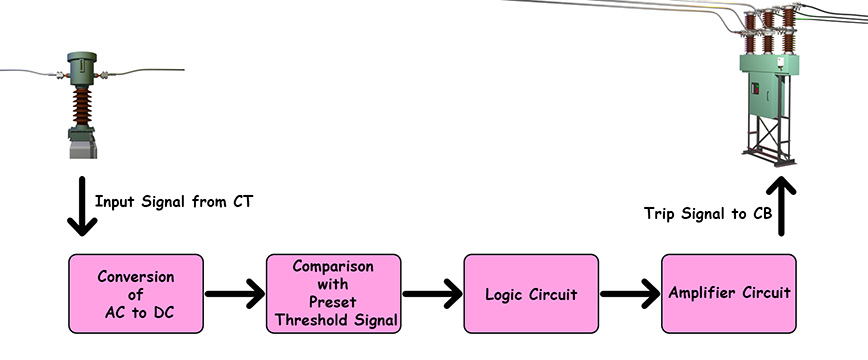A static electrical relay is a protection relay. It uses solid-state electronic circuits. Additionally, it does not contain any electromagnetic coils or moving parts. Therefore, we refer to it as a static relay.
Basic Structure of an Electrical Static Relay
A static relay operates using electronic components and circuits. For example, these components include diodes, transistors, op-amps, comparators, and logic circuits etc. Unlike an electromagnetic relay, a static relay has few functional stages. Its structure comprises three main sections.
Input Signal Conditioning: The first section of the relay receives input from CTs or VTs. This section includes filters, rectifiers, isolators, and attenuators. This section converts the AC signal to a usable DC form for measurement.
Measuring Unit (Comparator / Op-Amp Section): This is the core of the static relay. Actually, a relay is a device that operates beyond a preset threshold value. Obviously, this is the basic theory of any relay. This section compares the rectified input signal with the preset threshold signal. This section comprises a comparator or an Op-Amp circuit to compare the rectified input signal with a set reference value. So, it determines whether the fault exceeds the threshold or not.
Logic Circuit: This section of the relay implements relay logic using AND, OR, and NOT gates. This section also provides time delay functions if needed.
Amplifier Circuit: Following the logic circuit, there is an amplifier circuit. It amplifies the logic signal. This section offers sufficient power to trip the circuit breaker. This section uses transistors, thyristors, or relays for final switching. In other words, we can say it isolates low-power logic circuits from high-power trip coils.

Advantages of Electrical Static Relays
No Moving Parts: A static relay utilizes only solid-state components. This is why there is no mechanical wear and tear. Obviousely, it offers longer life and better reliability.
High Accuracy and Sensitivity: A static electrical relay can detect very tiny changes in electrical quantities. It can do it more accurately than an electromagnetic relay.
Fast Operation: This type of relay gives a swift response time due to its electronic circuits. Hence, the relays become essential for modern protection systems.
Low Burden on CTs and VTs: It is one of the most usable advantages of an electrical static relay. It requires minimal input burden. Hence, the requirement for the burden rating of a CT or PT reduces.
Stable and Consistent Performance: The temperature, vibration, dust, or mechanical shocks can not significantly affect the operating characteristics.
Flexible Characteristics: We can easily modify time-current curves, thresholds, and logic. Actually, we can change the characteristics by adjusting electronic components.
Compact and Lightweight: An electrical static relay is smaller in size compared to electromagnetic relays. We can easily accommodate static electrical relays in modern, smaller control panels for space-limited installations.
Better Isolation and Safety: The absence of moving contacts improves the safe operation. There is no chance of contact tears and welding due to arcing.
Low Power Consumption: A static electrical relay consumes significantly less power than an electromagnetic relay. Providing the mechanical movement of the coil’s plunger in an electromagnetic relay requires a significant amount of electrical power. However, an electrical electrostatic relay is free from such movements.
Disadvantages of Static Relays
Sensitive to System Transients: Static relays may operate incorrectly under switching surges or harmonics if not properly filtered.
Require Auxiliary DC Supply: This relay always needs a regulated DC source for internal electronic circuits.
Complex Repair: We can not repair it easily at the component level. Additionally, we often have to replace the complete module without repairing it.
Susceptible to Electronic Component Failure: There are many sections in a static relay. A defect in any part of any section can lead to the maloperation of the entire relay.
Limited Fault-Recording and Communication: Compared to microprocessor-based relays, static relays lack advanced features.
Calibration Drift: The threshold may shift slightly due to the aging of electronic components.
